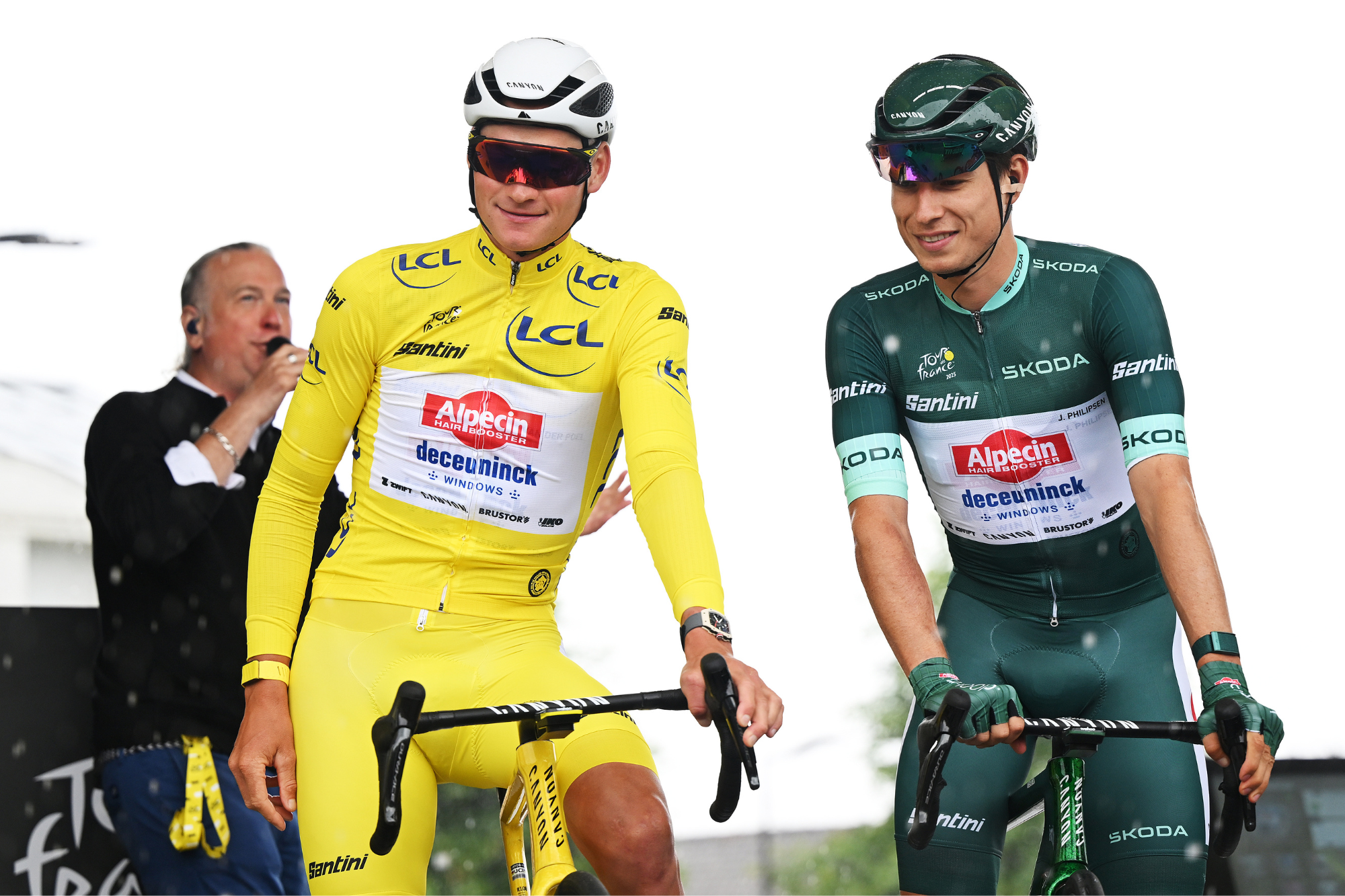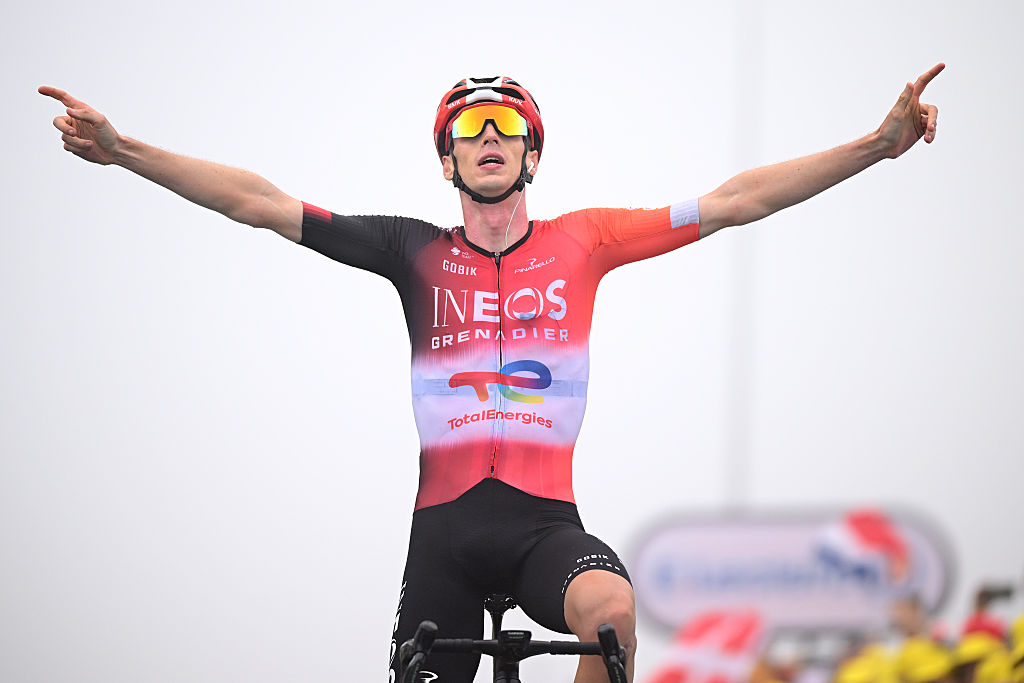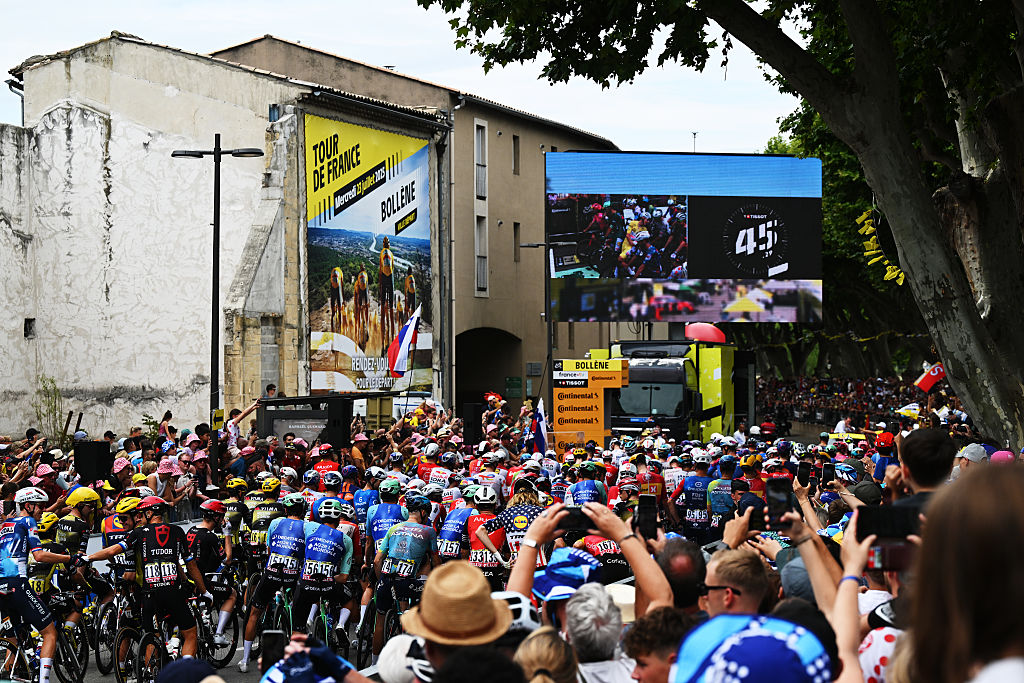Look around the Tour de France and you’ll see 38 sponsors – some huge international companies – lending their name to the 23 competing teams. The collective annual budget of the teams is, according to an official UCI document seen by Cycling Weekly, in excess of €600m. Top-tier cycling, on the face of it, looks richer, healthier and more financially sustainable than ever before.
But those headline figures don’t tell the full story. One team manager at the race told Cycling Weekly that 15 of those teams are currently searching for new title sponsors who will invest significant seven-figure sums, and no one else who CW spoke to disputed or was surprised by that number.
Indeed, due to sponsors withdrawing their funding and struggles to find new sponsors, Arkéa-B&B Hotels look almost certain to close operations at the end of this season; Intermarché-Wanty and Lotto are set to merge, leaving around 30 riders and dozens of staff unemployed; Alpecin-Deceuninck, the team of Mathieu van der Poel, can’t find a replacement for the exiting Deceunick; Ineos Grenadiers continue to search for additional funds, despite a new partnership with TotalEnergies; and CW understands that Quick-Step’s two-decade-plus relationship with the Belgian team of Remco Evenepoel is at risk of ending.
All of which leads to the question: why are so many teams in desperate need of new money? Is it because the sport isn’t as attractive as it used to be, or because budgets have skyrocketed? And should we, as fans, be as concerned as the panicking team managers?

Mathieu van der Poel and Jasper Philipsen’s team are without a second title sponsor for 2026
(Image credit: Getty Images)
To start with the good, big money is flowing into cycling. Not only have we seen nations – Bahrain, UAE, Kazakhstan and to some extent Saudi Arabia – invest in cycling teams in the past decade, but more recently Lidl, Decathlon and Red Bull, massive European companies with a worldwide reach, have poured money into the sport.
Calculating ROI

(Image credit: Getty Images)
When Ineos Grenadiers announced in March that they had recruited the services of marketing company Sportfive to help them find new money, it took some by surprise as it was an indication that despite having a storied history and boasting Grand Tour winners in their current roster, the British team had so far been unable to entice businesses in private conversations. And it’s those boardroom meetings that happen through word of mouth how most business deals are still agreed in the sport.
“A lot of cycling is related to the personal relation you have with people,” Lidl-Trek chief Guercilena says. “It’s true that a company will contact you because an ex-rider or -staff got in touch with the organisation to tell them to sponsor cycling. During the season the job is to always keep good relationships with sponsors and ex-riders and -staff even when they’re not working for you anymore.”
It’s often said that in the absence of few tangible assets and no fixed home rooted in one specific place – no cycling team has a home stadium that fans pay to visit, for example – the return of investment for sponsors on cycling is low. But WorldTour teams commission annual brand exposure and media value reports, and CW has seen one document from a WorldTour team which breaks down how title sponsors actually get up to three times more exposure and value from sponsoring a team than the money they invest.
Keeping the payees regularly informed of where their money is going and how it’s beneficial to them is a regular task. “We still keep the historical analysis of media value, looking at the free TV channels, streaming channels, social media and so on,” Guercilena says. “We also do a lot of analysis of customers, their loyalty to the brands, and the increase in customers related to the team and the interaction of content we create on top of the typical TV broadcasting.”
Dominique Serieys is the general manager of Decathlon AG2R La Mondiale, and just as the Tour began his French team announced that Decathlon – a French sports retail company that operates in 79 countries – had bought the team’s licence from its long-time partners AG2R La Mondiale, and that maritime logistics company CMA CGM would come on-board as co-title sponsors from 2026. “We were quite surprised how many different high-level brands were interested in pro cycling, and were opening the door, listening to us and studying our project,” Serieys tells Cycling Weekly. “There were maybe 10-15, and some were big worldwide companies, so we were proud.”
Other team managers report similar stories of meetings with recognised multinational companies. They all point to growing audience numbers of the Tour de France – still the world’s biggest and most prestigious race – and how fewer doping scandals are interesting businesses more than ever; cycling, they say, is cool and chic once again – brands want to be associated with the sport. But it’s precisely that – big companies wanting and demanding to be associated with the best – that is driving the current panic to find new sponsors.
The latest race content, interviews, features, reviews and expert buying guides, direct to your inbox!
Cédric Vasseur is the manager of the French WorldTour team Cofidis. Since 1997 the French credit company has been the sole title sponsor of the team, and in that period Vasseur has watched his competitors outgrow his team substantially. “The fact that 15 of the Tour de France teams are looking for sponsors means we [as a sport in general] are trying to increase our budgets,” the Frenchman says. “Of course, we all want to have more budget, but I don’t think the economical situation is making it possible. It shouldn’t be possible that in one year 15 teams are looking to increase their budget. I think maybe cycling is setting its standards too high.”
What Vasseur is getting at is that in the race to be the best, cycling teams are inversely racing to the bottom; being greedy and desperate in an attempt to overhaul the likes of UAE-Team Emirates XRG is running the risk of becoming bankrupt and irrelevant. If UAE’s reported budget of around €55m was to become the baseline figure, WorldTour teams would need to find a collective half-a-billion euros more – an event that simply isn’t happening any time soon.
“If you’re having UAE, Bahrain, Astana, these are countries, so their budget is more unlimited than if you’ve got a company,” Vasseur says. “If you look back, the budget of cycling has exploded in the last 15 years – it’s just unbelievable. We of course still need to improve all of the time, but we have to realistic that it’s not possible to double the budget just like that.”

23 teams, and 15 are looking for new investment.
(Image credit: Getty Images)
Luca Guercilena, who as the general manager of Lidl-Trek persuaded European supermarket giant Lidl to join his team just over a year ago, shares a similar perspective. “We have very good sponsors, but it’s clear that certain other companies have maximised their amount of investment [in cycling],” he said. “Maybe a team has a main sponsor, but they’re looking for a bigger one because it’s not easy to find €50m to fund a team. That’s why there are 15 teams looking for a sponsor.”
Making their debuts in the Tour this season are Tudor Pro Cycling, founded by Classics legend Fabian Cancellara. Only in existence for four years, the Swiss team have big ambitions and hope to be a WorldTour team by 2028. Raphael Meyer is the team’s manager and he highlighted the roles he and his peers play in driving the price up of running a team. “It’s me and my colleagues who are the ones who always find the money to pay a rider more,” Meyer says. “If you only see your team getting better by injecting more money, and therefore hiring bigger riders, then the ultimate consequence is that you need more money.”
That, Meyer says, is a method that doesn’t yield to long-term financial sustainability. “It’s something you should try to avoid but is probably done quite often: if you can’t find money, then you need to squeeze in other areas or find it externally to have more money to invest in riders. [But] you can’t lose your foundation because you need to find more money. Riders come and go, and the structure that defines the team and creates its value should remain.”

Lidl-Trek are now one of the richest teams in the sport after Lidl’s arrival midway through 2024.
(Image credit: Getty Images)
Escape Collective produced a deep-dive into the finances of WorldTour budgets in June, revealing how the total revenue of the 18 WorldTour teams increased by 32% – or €120m – from 2021 to 2024. That led Jayco-AlUla general manager Brent Copeland to express what many others are also saying: the sport’s unquenchable thirst for growth could lead to its own collapse.
“Big multinational companies invest a substantial amount of time doing the calculation on return on advertising spend before they have their board meetings and say, ‘Right, how much is it going to cost us to put our name on the jersey of Manchester City or Inter Milan, or a Formula 1 or MotoGP team,” Copeland told Escape. “And we’re getting to the point where the top teams in cycling are surpassing those sports by quite a significant amount. Serie A football teams are asking less than many cycling teams for real estate sponsorship space. Without a budget cap, we increase the risk of the teams losing sponsorship because [businesses] will start to look at the numbers and go to other sports.”
Whether or not a budget cap comes is something that the UCI, the sport’s governors, are currently exploring. Attempts to reform the sport’s economic model and calendar also continue apace. Cycling is in a moment of transition, and caught in the middle are two polarising themes: the age-old problem of mostly mid-ranked teams losing sponsors for a variety of reasons, and then all teams – but especially the best-performing – needing more money to be more competitive and to satisfy an increasingly demanding paying agent. It’s a constant battle to remain afloat.
It would be easy to be pessimistic, but Guercilena says the outlook is far more positive than what it seems. “In the last few years it is evident that, despite the business model, sponsors are coming as they see cycling as a sport to invest in: the lifestyle, the healthy nutrition aspect of it, like it happened with us and Lidl, and the idea to have green mobility,” the Italian says. “I see this happening more often, and it’s no longer like in the past when this was a cheap sport for its price. More and more it’s a real marketing investment, with clear ideas to promote content for the company, and that’s very good.”